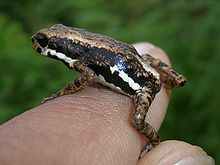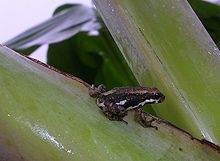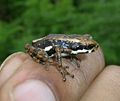- Pedostibes tuberculosus
-
Malabar Tree Toad 
Conservation status Scientific classification Kingdom: Animalia Phylum: Chordata Class: Amphibia Order: Anura Family: Bufonidae Genus: Pedostibes Species: P. tuberculosus Binomial name Pedostibes tuberculosus
Günther, 1876Synonyms Nectophryne tuberculosus
The Malabar Tree Toad or Warty Asian Tree Toad (Pedostibes tuberculosus) is a species of toad found in forests along the Western Ghats of India south of Goa. It is small and is found in wet tree hollows or leaf bases containing water.
Description
This is a slender frog with a moderate sized head. The snout is pointed and the lores are vertical. The distance between the eyes is as wide as the upper eyelid width. The ear opening (tympanum) is well marked and is about a third of the diameter of the eye. The finger are moderate, depressed and webbed a the base. The first finger is half the length of the second. The toes are almost entirely webbed and the tips of both fingers and toes are dilated into broad truncated disks being smaller on the toes. The tubercle near the joint is small and there are tow small flat metatarsal tubercles. There is no tarsal fold. When the hind limb is held straight beside the body small the metatarsal tubercles reach to between the eye and tip of the snout. Skin of upper parts rough (tubercular), the largest tubercles being arranged along each side of the back. Brownish grey above, sides darker; a white band from below the eye to the axil; another white longitudinal band in the lumbar region; beneath dark-spotted. Male with a subgular vocal sac.[1] Females are larger than males. Adult of this toad reach between 3.6-3.85 cm in length.
The call is described as a shirrrr shirr shirr shirr with a dominant frequency of 3780 Hz, each call lasting 3 to 7 seconds with 3 to 10 pulses.[2]
From snout to vent 1.4 inches.
Habitat
This species is known to live in tree habitats but adults are found among leaf litter, climbing into trees at night. They are found in the forest of the Western Ghats at elevations of 250 m to over 1000 m often beside streams.[3]
References
Categories:- IUCN Red List endangered species
- Frogs of India
Wikimedia Foundation. 2010.





